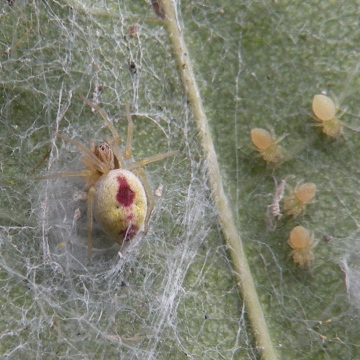Notes on Nigma puella

On the 19/07/16 I found a gravid female on a Buddleia in my garden and the next day she produced an egg sac. Over the next several days I kept up my observations, checking progress at 11pm, 6am and also when I returned from work in the evenings around 6pm. 28/07/16, 8 days after she had produced the egg sac, on checking I noticed that the egg sac was open and and it appeared as if it had been predated on and the female was still very large though there wasn't any evidence of prey items amongst the cribellate silk, which is fairly usual for mesh weavers. The next day, 29/07/16 she was gone and I thought nothing more of it. So this morning 06/08/16, I'm in the garden and whilst checking the buddleia, I noticed a small creamy spiderling. I got my hand lens and lo and behold, a N.puella spiderling. I continued checking and more spiderlings started turning up, including 2 that had captured parasitic wasps. It's worth noting that these wasps really are a spiders greatest foe, but when it comes to cribellate spiders that use a woolly silk, they don't stand a chance, the fibres easily entangling the legs of the wasps or other flying insect. So the search continued and I eventually found the leaf with the females retreat with 2 spiderlings at the entrance and also a brown mass unknown to me. The female was tucked away unfortunately, so I was unable to get a photo. Now, the mystery part. What happened to the first egg sac? Predated? Did the female eat it? As I said she was still very large and no prey items in her web. I also have to ask myself, did I have more than one N.puella on the buddleia? It's not a big plant and I've searched it many times with a fine tooth comb and have found no evidence of other N.puella, but if only one, it surely isn't possible for the single spider to find another leaf, build a retreat, produce an egg sac and spiderlings emerge in 9 days...Nah, even after writing and reading that back, not possible....2 different N.puella's I think
Added by Tone Killick at 13:48 on Sat 17th Sep 2016. Return to Summary for Nigma puella